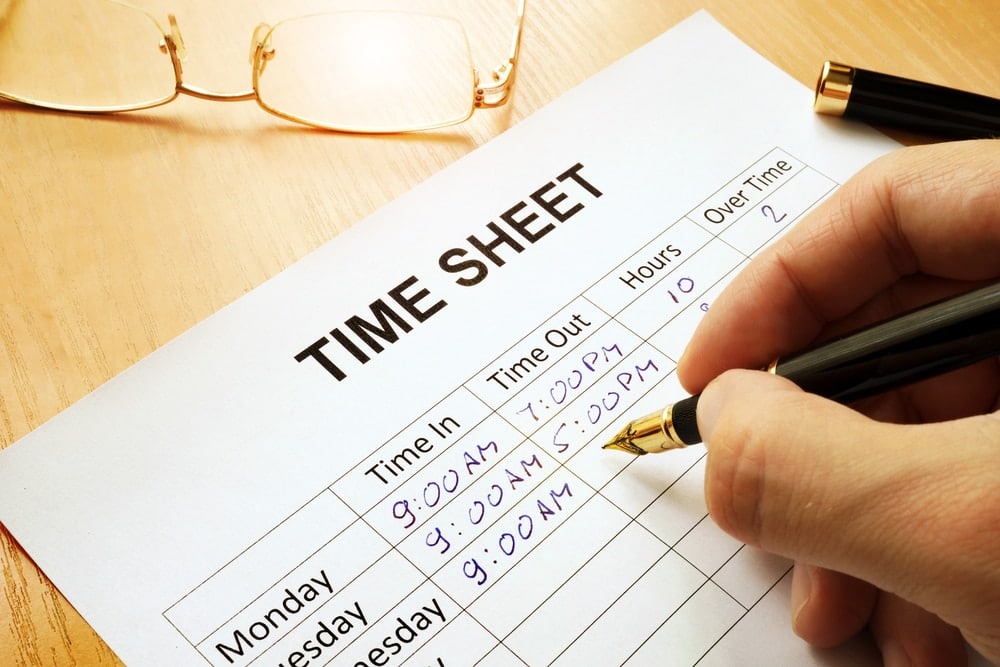The law requires you to track hours for hourly employees
Employers are required by federal and state laws to track the hours worked by non-exempt employees and follow the strict time clock rules for hourly employees. And while hourly employees are typically non-exempt you need to keep in mind that some salaried workers may fall under the same category.
This means the Fair Labor Standards Act (FLSA) requires you to track the hours of hourly and non-exempt salaried workers, while exempt salaried employees don’t need to clock in or out. Because the exempt salaried employee is not eligible for overtime pay and they have regular, annual salaries.
Additionally, some companies need on-call workers and that can be a problem when it comes to login in during the waiting hours. Depending on the type of the on-call arrangement and the state where the company is located there are two different options:
- Restricted on-call duty
This type of on-duty employment requires the employee to be on the work premises and available for work in minutes when needed. Because the employee is not able to leave work and has to wait for the engagement the employer has to compensate for those hours.
If the employee is engaged in duty they have the right to a regular hourly rate for the time waiting and hours worked. This includes the traveling time.
- Unrestricted on-call duty
In case the employee is on-call but able to leave the work premises the hours spent waiting for the call are not compensated, considering the employee had the time to spend on personal matters.
If the employee does get the call and goes to work they should be paid the regular hourly wage and the traveling time is included. The laws are focusing more on regulating the on-call duties and ensuring the employees have a healthy life and work balance, so it’s recommended to avoid the restricted on-call when the profession allows it.
While it can be challenging to track the hours of each employee, it’s a vital part of the legal security of your company. It’s easy to overlook the overtime hours and follow time clock rules wrong without even realizing it.
Employers can use a wide variety of time tracking methods
While it’s mandatory for employers to track hours there are no technical and precisely described ways to implement a time tracking system in the law. As long as the hours are properly tracked the method is not important. However, even then it’s easier to rely on automated and modern time tracking methods.
This leaves you with plenty of choices, including:
- Printed timesheet the employees have to fill out
- Punch-card systems
- Scanners that automatically log in worker’s cards
- GPS time clock app for mobile phones with in-built job scheduling
The records need to include certain information about the hourly employee that is regulated by the U.S. Department of Labor.
The employer needs to maintain basic records that include:
- Employee’s full name and social security number
- Address.
- Birth date, if younger than 19.
- Sex and occupation.
- Time and day of the week when an employee’s workweek begins.
- Employee’s hours worked each day.
- Total hours worked each workweek.
- The basis on which employee’s wages are paid
- Regular hourly pay rate.
- Total daily or weekly straight-time earnings.
- Total overtime earnings for the workweek.
- All additions to or deductions from the employee’s wages.
- Total wages paid each pay period.
- Date of payment and the pay period covered by the payment.
Because of the complex tracking when companies have large and different teams it’s easier to rely on GPS time clock apps that do all the data input for you and ensure accuracy and compliance. This way you can be sure you are following all the time clock rules for hourly employees and regulations in your state, and your employees have a better overview of the schedule and hours.
Rounding rules and the 7-minute rule
Employers need to track the hours and ensure that every hour worked is properly compensated, but in doing so many employers choose to clock in and out time to the minute while others practice rounding up numbers to the nearest quarter hour.
Employers have the option to use hour increments to calculate the hours worked and choose if they want to round up to the nearest 5, 6, or 15 minutes. But, even with free calculations like these, it’s important to avoid always rounding down considering the employer could violate federal laws.
To lower the chances of accidental miscalculations and rounding down, the employer can use the 7-minute rule. This simple rule implies that if the minutes logging in are 1 to 7 you should round it to the previous increment. On the other hand, if the minutes are 8 to 14 you should round it up into subsequent increments.
To understand the 7-minute rule better here is a simple example:
- If the employee arrives at 8:04 the hours are tracked from 8 o’clock.
- If the employee clocks in at 8:09 the hours logged in begin at 8:15
The 7-minute rule is easy to follow and leaves less room for miscommunication and unnecessary tension in the workplace.
Employees must always be paid for hours worked, even if they don’t record them
In the Guide to the Fair Labor Standards Act, you will find that every hour worked needs to be compensated, even in cases where the hourly employees didn’t record it. So, regardless of the method, you might use to track time, and the fact that it can happen that some hours are not noted, you as the employer need to pay the employee.
This is one of many reasons why it’s a good call to use a GPS time clock app that will automatically remind workers to clock in, eliminate human error and help you stay on track with logging in and out of work. The app is fully functional on all mobile devices and automatically tracks all the hours, wages and overtime.
You cannot make employees work off the clock
It’s not allowed for non-exempt salaried and hourly employees to work off the clock under any circumstances whether it’s voluntarily or ordered by supervisors. It’s not always easy to determine what off-the-clock work might be so keep in mind that any work-related action is considered labor and needs to be compensated.
Even if the employee is trying to impress the business owner, help a customer or clean up after they clocked out it’s considered working off the clock. This law violation can lead to serious penalties and lawsuits.
Here are a few examples to better understand working off the clock:
- The employee sets up everything before clocking in
- After clocking out the employee is asked to clean up
- The employee helps out a customer after the shift has ended
- The employee is asked or chooses to work during the lunch break
So, any hour worked needs to be paid if you want to avoid potential problems with the law and possible lawsuits.
You are allowed to adjust employee time cards and create them on their behalf
Even though it’s not always the best solution the employer is allowed to create and change time cards for the employees. As long as the employee is paid for every hour worked the employer can make changes without even notifying the worker.
But, considering this can cause unnecessary tension you should consider using the time tracking software that your employees can access and see a complete audit trail of changes made including the reasons for the changes. It’s important to choose an app that your employees can use with ease even if they are busy and not tech savvy.
The Fair Labor Standards Act requires you to pay overtime
The non-exempt workers and even non-exempt salaried workers are under the protection of the FLSA which requires you to pay for every hour worked overtime. Regulations can vary from one state to another, but if we take California rules on overtime pay you need to compensate 1.5 times the hourly rate for:
- Employees that worked for more than 8 hours up to 12 hours in one day
- The first eight hours of the seventh day, for employees that work for seven consecutive days
- Employees that clocked in more than 40 hours in one week
In addition, if the employee works for more than 12 hours per day, or over eight hours on the seventh day the employer needs to compensate them double the standard hourly rate.
So, the employees need to be compensated for every hour worked, and the hourly wage changes for overtime. That’s why keeping track of hours worked can be quite challenging and very important to maintain if you want to have a successful business strategy. It’s crucial to understand and follow the overtime rules in your state and keep the time tracking legal.
Understand & track minimum rest break requirements
Meal and rest breaks are not mandatory in every state and it’s not a requirement covered by the FLSA, however, state labor laws can be quite different. Depending on the state and the agreement the employers have with the non-exempt employees the tracking minimum rest break is very different.
In general, federal law requires any breaks that are less than 20 minutes to be paid. In case the rest period is longer than 30 minutes and the employee is relieved of all work-related tasks this is not paid.
But, if we take the state labor laws in California for example that states “½ hour, if work is for more than 5 hours per day, except when workday will be completed in 6 hours or less and there is a mutual employer/employee consent to waive meal period.” So, state laws require employers to not only allow and track the employee hours on the break but also pay special attention to the way the employees are using the break.
The problem can happen if the worker still has some work-related tasks and decides to work through the break. This is against the time clock rules for hourly employees and requires the employer to compensate them for those hours too. This can add up and cause overtime pay or illegal working off the clock.
The employees need to have a good and reliable way to track hours worked and put in the exact time when they are on break and when they come back. This is easily achieved with the apps that track employee time.
Using technology to ensure compliance
Time clock rules for hourly employees can be challenging to maintain and follow, in particular, if you are not leveraging technology to ensure accuracy and minimize your admin time. Modern time tracking apps help you as an employer and your team of employees with features such as:
- Reminders to clock-in and clock out.
- Automatical detection and calculation of overtime hours
- Reminder for the employees to take breaks
- Creation of accurate records when the break periods happen
- GPS to increase transparency, ensure time card accuracy and reduce disputes
- Providing a GPS trace gives you concrete evidence when you need to adjust a time card
With the Workyard time tracking app you will be able to track time easily, stay on top of the federal and state laws as the algorithm does everything for you, and automatically calculate overtime pay. It’s also very user-friendly and your employees can clock in and out in a couple of taps. Sign up for a free trial of Workyard today!





